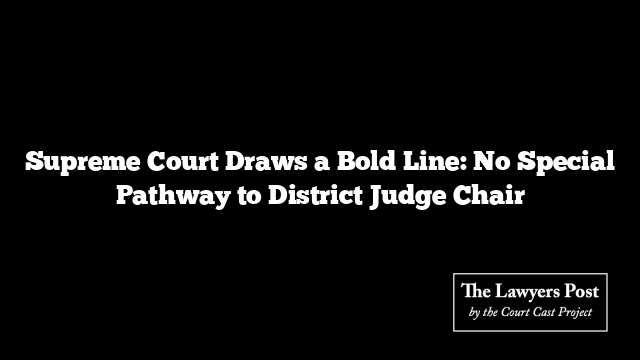In a judgment that slices cleanly through years of quiet murmurs and simmering discontent, the Supreme Court has declared that the road to becoming a District Judge will remain one, not many — and certainly not one with shortcuts for any faction of the Higher Judicial Service.
A five-judge bench, led by the Chief Justice of India, made it clear that the judiciary’s internal ladder cannot be carved into compartments to soothe what it described as mere “heartburn.” Once officers enter the common cadre — whether by regular promotion, limited competitive exam, or direct recruitment — they shed the labels of their origin. Birthmarks fade; seniority starts anew.
The Court dismissed the idea that those who climb their way up through the Civil Judge ranks deserve extra credit when they reach the District Judge threshold. Performance and tenure in the lower courts, the bench held, have no role in determining seniority within the HJS. Only merit and seniority within the cadre itself matter.
The judges also pointed out that promotional avenues for in-service officers have already broadened. Recent rulings now allow them to contest for direct recruitment posts. Service-period conditions for moving into senior divisions have been relaxed. The institution, the Court implied, is not squeezing them out — the pipeline is already widening.
But aspiration, the bench noted, cannot be elevated to a legal principle.
The New Seniority Rulebook
Invoking its extraordinary constitutional powers, the Court has now laid down a binding roadmap for how District Judge posts must be filled across the country:
-
Seniority will follow a 4-point annual roster:
2 Regular Promotees → 1 LDCE recruit → 1 Direct Recruit, repeating every year. -
Officers appointed after delays may still claim seniority from the year the recruitment process began — but only if no later-year appointments have intervened.
-
When vacancies from LDCE or direct recruitment remain unfilled, they may be assigned to promotees — but promotees must occupy only promotee slots in subsequent roster cycles, keeping the 50:25:25 balance intact.
-
Each State’s rules, framed with its High Court, must now be updated to reflect these binding principles.
And to avoid another wave of litigation, the Court added a final guardrail: these guidelines will not disturb settled seniority battles. They apply going forward, not backward.
The bench concluded by noting that these directions reflect the current landscape and may evolve with future needs — but for now, the hierarchy of the Higher Judicial Service has a clear compass, and everyone, regardless of the path taken to enter it, must walk by it.





